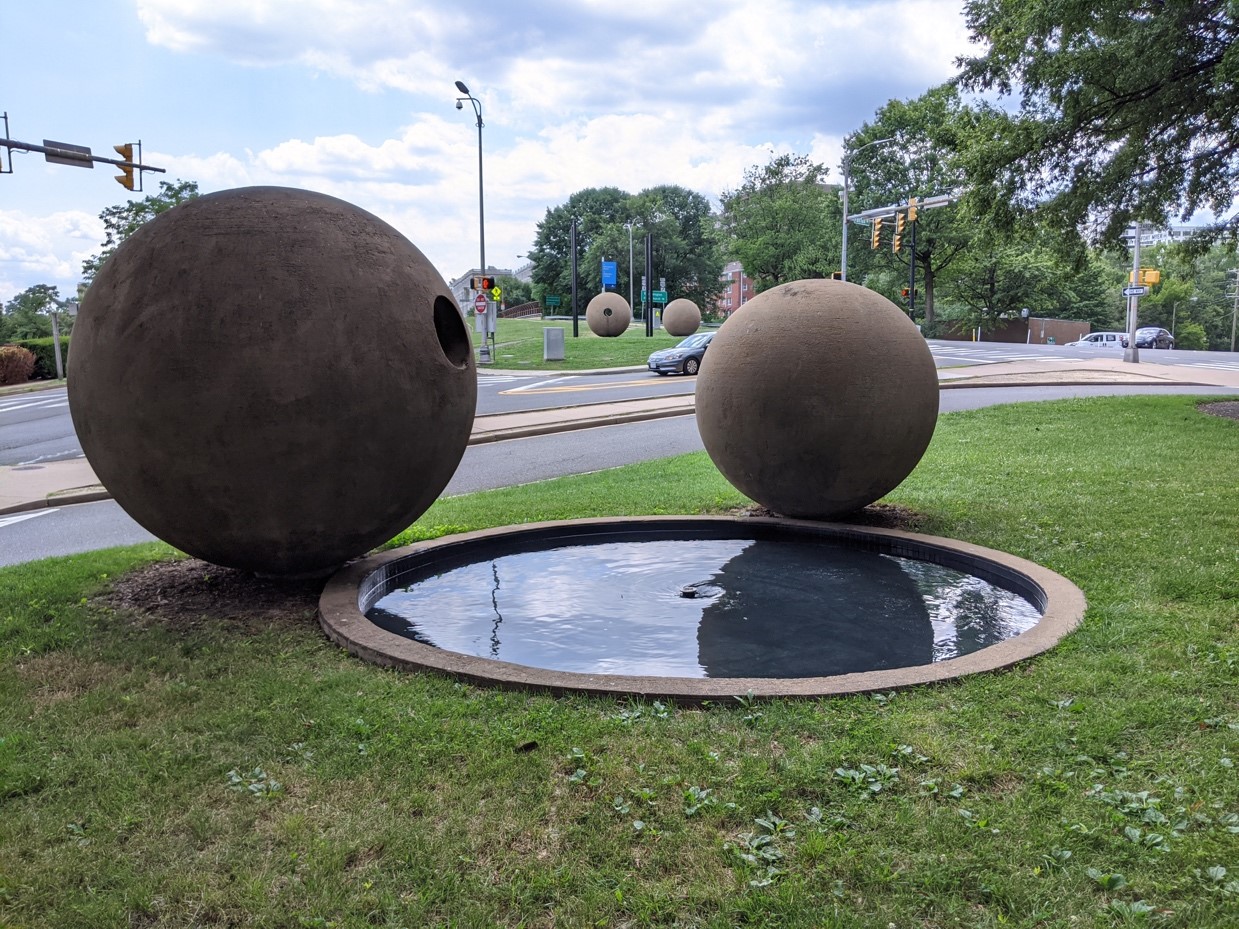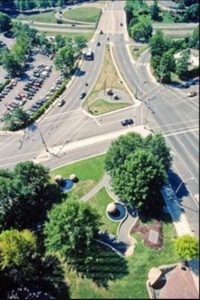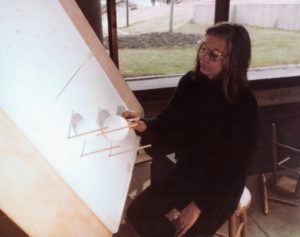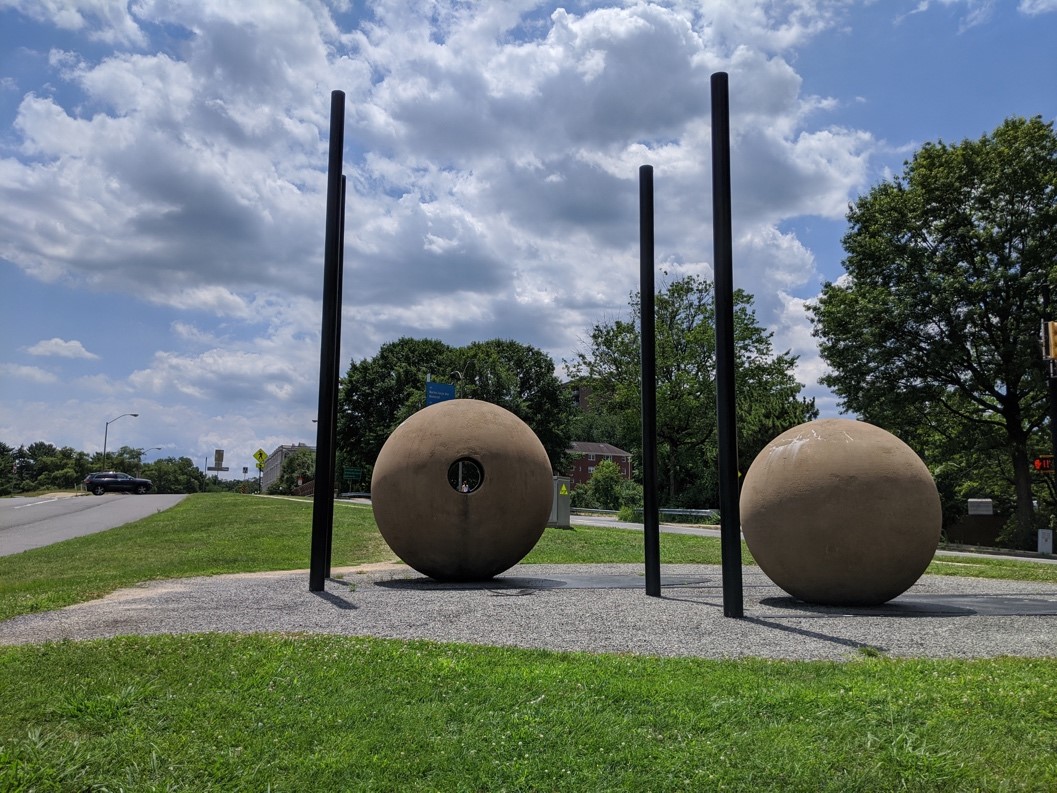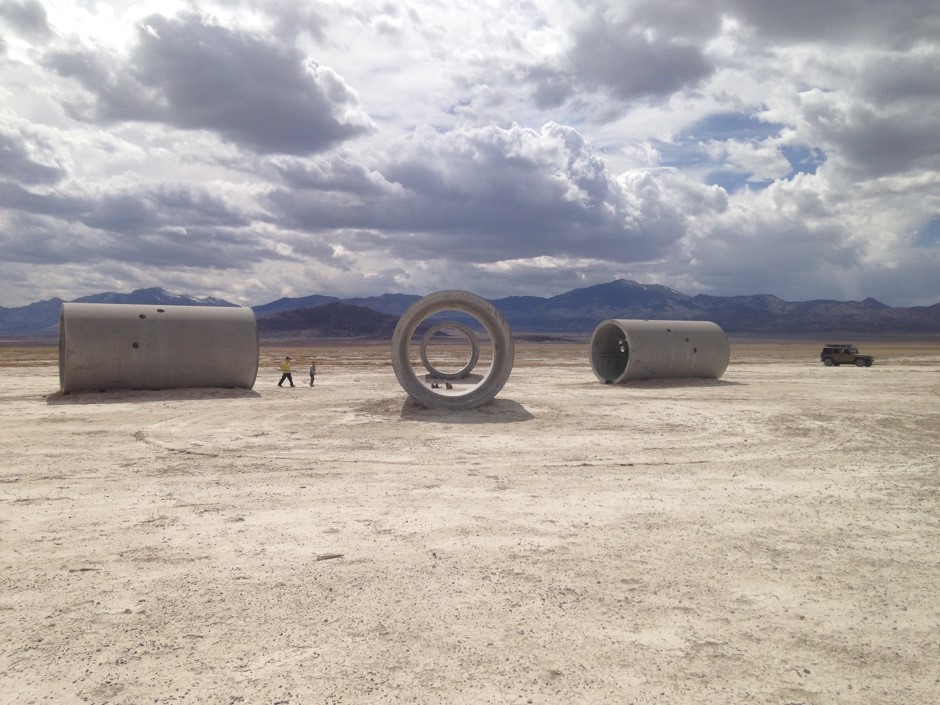One of the reflecting pools at Dark Star Park. Image courtesy of Camryn Bell.
Embedded between the office buildings, businesses, and roadways of Rosslyn is a unique piece of public art - Dark Star Park. Each summer, at approximately 9:30 a.m. on August 1, morning light strikes the group of large spheres that make up the sculpture to create an eclipse-like effect, which lasts - much like a real eclipse - only for a few minutes.
How did this unusual public sculpture come to be?
Dark Star Park 35th Anniversary Celebration – this Arlington TV feature showcases the August 1st, 2019, alignment of light and shadow at the park, and is accompanied by an original score from local artists Janel and Anthony.
Built in 1984, Dark Star Park is the entry to the Rosslyn neighborhood, at a triangle formed by the intersection of North Fort Myer Drive, North Lynn Street, and N. Meade Street. It was constructed on the site of a former gas station, occupies 0.4 acres of land, and was designed to commemorate the anniversary of the purchase of the land by William Henry Ross, which would later become Rosslyn (Ross served as the neighborhood's namesake).
Aerial view of Dark Star Park. Image courtesy of Arlington County.
Artist Nancy Holt (1938-2014), who was chosen to helm the project in 1979, was somewhat apprehensive about the project upon entering Rosslyn, in part because the site was a vacant lot overrun with trash. In a 1988 documentary on the park, she said, “I was overwhelmed with how cold and distant a place Rosslyn was … It’s a concrete network here with very little thought about human beings, human scale, human maneuverability.”
Nancy Holt designing Dark Star Park. Image courtesy of the Holt/Smithson Foundation via DCist.
Dark Star Park combines elements of landscape architecture, sculpture, and astronomy. The piece is comprised of five gunite (air-placed concrete) spheres resembling fallen, extinguished stars, as well as two pools, four steel poles, and two tunnels.
Dark Star Park was commissioned by Arlington County during a transitional time in Rosslyn - the Metro had recently arrived in Arlington, and development was still on the rise. The County funded the project with $200,000 from public and private sources, as well as a National Endowment for the Arts grant. (DCist, July 30, 2019)
Some of the gunite spheres and steel poles at Dark Star Park. Image courtesy of Camryn Bell.
Holt oversaw every aspect of the park’s design and development, and also served as a contractor on the project. She was a preeminent member of the land art movement, which rose to recognition in the 1970s. While practitioners of this style mainly concentrated in open natural spaces – places that could easily accommodate the monumental scale of the works associated with the movement – Holt’s work in Dark Star Park was unique due to its urban setting. In terms of her design approach, Holt said,
“I feel that the need to look at the sky—at the moon and the stars—is very basic, and it is inside all of us. So when I say my work is an exteriorization of my own inner reality, I mean I am giving back to people through art what they already have in them.”
Some of Holt’s other pieces were located in much larger environments than Dark Star Park. "Sun Tunnels," 1973-1976, is located in the Great Basin Desert of Utah. Image courtesy of the Utah Museum of Fine Arts.
The creation of Dark Star Park marked a significant first for the Arlington area: it was the first work of public art produced by the County. This was prior to the establishment of the County’s formal public art program that was inaugurated with the adoption of a Public Art Policy – nearly 16 years after the creation of Dark Star Park.
In the decades since, Arlington’s public art program has become a robust part of the County landscape.
Dark Star Park itself is also one of the first national examples of “integrated public art,” meaning that the art in the public site is inseparable from its setting and is a total environment to be experienced holistically.
Excerpt from December 9, 1993, article by Mary McCoy on public art in Arlington and Dark Star Park. From the Washington Post.
Holt planned the design of Dark Star Park using miniature clay models. She worked with astrophysicists to determine placement of the spheres and poles to align with the light at exactly 9:32 a.m. on the August 1 anniversary – a time of day chosen simply because Holt enjoyed the way the light hit at that moment. The need for exactness in alignment was in part why the park underwent a renovation in 2002, allowing Holt to reorient the spheres that had shifted over the years due to the changes in the Earth’s axis.
One common mistake about Dark Star Park Day is that the August 1 alignment is meant to celebrate the birthday of Grateful Dead lead guitarist Jerry Garcia. This assumption is compounded by the coincidence of the band’s song titled “Dark Star.”
NewsMakers: Dark Star Park – an Arlington TV feature on Dark Star Park from 2009, including a speech from Nancy Holt.
Learn more:
The documentary "Troublemakers" – available at the Library – discusses the history of the land art movement and features Nancy Holt.
The DVD "Art in the Public Eye: The Making of Dark Star Park" by Nancy Holt is available for viewing in the Center for Local History.
Do you have a question about this story, or a personal experience to share?
Use this form to send a message to the Center for Local History.
Center For Local History - Blog Post Message Form
Do you have a question about this story, or a personal experience to share? Use this form to send a message to the Center for Local History.
"*" indicates required fields
